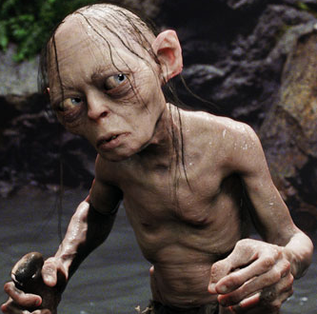The Golem

How do we create life from inanimate matter? We can't.
But, medieval Jewish alchemists and Kabbalists thought it might be possible. The Golem has had an illustrious history ever since, well, the mid-19th century. Most of his history before that appears to be projections back in time - notably to late 16th century Prague where Rabbi Jehuda Loew ben Bezalel apparently first created one and stashed him in the attic of the synagogue. Skeptics say the wrong guy got the credit. The fable about the Rabbi and the Golem protecting the Jews of Prague and smiting the anti-Semites seems to be more recent.
The Golem story really has its origins in the story of Adam - God takes a lump of earth and speaks the divine words, breathing life into it - Adam being the first Golem. It seems to be human nature to believe that life can be created in this way: magic spells and a hot breath on inanimate objects. No doubt the Venus of Willendorf, shown up top, who is made of limestone even earlier, was similarly regarded. Maybe this story originated in China, where the Jade Emperor is said to created the first humans from clay?
This famous statue in Prague shows Franz Kafka sitting on the shoulder of... something. Many have speculated it's a Golem, since a Golem does appear in Kafka's writing.

In scientific terms this belief in breathing on inanimate objects is related to Vitalism. It is hard to see science ever being able to deal with it satisfactorily since Vitalism relies on a magical or religious view of the world. This reflects more on the limits of mechanistic science and the rigidity of many scientists rather than on the limits of religious belief. That said, the idea of infusing inanimate objects with life is not very persuasive.
Mary Shelley had her own take on the Golem fable in Frankenstein (1818) using electricity, influenced as she was more by Galvanism than Kabbalah. There is no evidence she she was familiar with the German, Czech and Polish Jewish legends about the Golem.

It also has been speculated by some that Tolkien's Gollum in The Lord of the Rings is a play on the name. Nowadays the Golem is also a Pokémon character and a potent means for attracting tourists to Prague. This upsets purists of course.
More recently, scientists have been saying that although we can't create life ourselves, obviously the universe is capable of it. "Luca" (the "Last Universal Common Ancestor") refers to a single-celled organism that may be the common ancestor of all life on Earth some 4.2 billion years ago, an Adam or Eve from which all other organisms have evolved. It may not have lived in Prague; it lived here:

